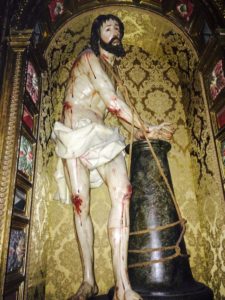
Jesus asks, ‘Who do you say that I am?’ Peter responds, “You are Christ, the son of the living God.’ In your contemplation, plumb the depths and implications of what Christ, Cristos, really means. Who is this anointed? This Y’shua? What does he mean to me? Jesus doesn’t ask, ‘Who do people say that I am? What are they talking about in the streets? What does the media say? What’s the public opinion?’ No. He asks, ‘Who do YOU say that I am?’
Ultimately, our destiny comes down to a decision. ‘Who do I say He is?’ In your answer to that question, how will you respond with your life?’
The person of Christ is unparalleled in history. There will be never anyone like Him, and there was never anyone like Him before He came on earth. He revolutionized human creation and redemption; he revolutionized our destinies.
Jesus Christ wasn’t simply a godly man or a religious figure; he was God made man. Some religions have incarnations of a mystical kind. However, Christ wasn’t just someone to be spoken about in mythological terms; His being is concrete and historical. The mystery of His humanity became an event in a specific time in history, with huge implications, and it only took Him three years to turn the world upside down. What He did is unlike anything else.
What Christ came to offer and invites us into is not just one religion among many; it is not something that we have invented and discovered. It is not just a human idea or philosophy. It’s God’s revelation of our eternal destiny in Him. What Christ has done is something that has been revealed. He invites us into a relationship with Him.
In many of his writings, Saint John Paul II writes about the theme of gazing, of contemplating upon the face of Jesus Christ. He describes the glory shining on the face of the risen Christ, as ‘supremely beautiful.’ During the Transfiguration, John, Peter, and James, and the two great figures of the old covenant, Elijah and Moses, gaze upon His face. We too are invited to do the same, that our lives may be transformed. By the discovery of who God is, we discover who we are.
When Saint Peter exclaims, “You are the Christ,’ Jesus responds, ‘That didn’t come from you.’ Peter did not come to this conclusion on his own. It was a gift from God that was infused in him so that he would have this knowledge, awareness, and epiphany.
After his epiphany of coming to know Jesus, our Lord gives Peter an epiphany of coming to know himself. Jesus says, ‘You are Peter. You’re no longer Simon, son of Jonah.’ Simon means sand; before Peter’s infused knowledge of Christ, he had very little stability. Only after Peter is able to gaze at Christ with the eyes of faith and know Him, does Jesus change his whole identity. He names him Peter, which means the rock.
And on this rock, Christ has built His Church. From Peter’s human weakness, Christ brings glory out of brokenness (to be continued).

May the Lord bless us, protect us from all evil and bring us to everlasting life.
(SOURCE: Denver Retreat, October 2015)